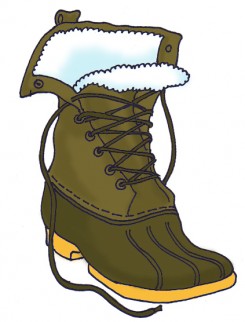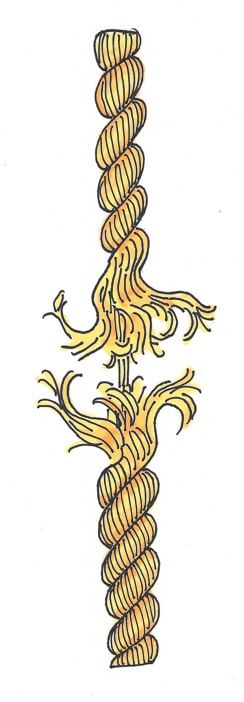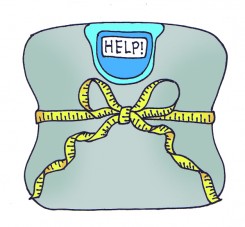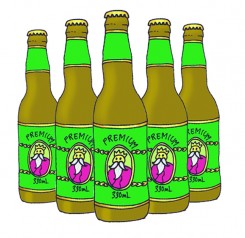Apparel
 You’re leaving home to head for class, and as soon as you step outside it hits you: your outfit cannot keep the sharp winter air at bay. Most of all, you wish you knew what the hell makes for a warm coat. The warmest outerwear is more or less made out of a combination of fleece, wool, high power white goose down, as well as exclusive patented fabrics like the North Face’s Polartec. Since snow is wet (mind-blowing), keep in mind that a Durable Water Repellent (DWR) finish on a winter coat or pair of snow pants will service you longer. The manufacturing of some of these materials can be taxing on the environment, so if you want to go for more eco-friendly coats, then opt for eco-friendly companies that specialize in recyclable and natural products. They are a bit hard to find and carry less stock than big name brands, but usually sell the same trendy styles.
You’re leaving home to head for class, and as soon as you step outside it hits you: your outfit cannot keep the sharp winter air at bay. Most of all, you wish you knew what the hell makes for a warm coat. The warmest outerwear is more or less made out of a combination of fleece, wool, high power white goose down, as well as exclusive patented fabrics like the North Face’s Polartec. Since snow is wet (mind-blowing), keep in mind that a Durable Water Repellent (DWR) finish on a winter coat or pair of snow pants will service you longer. The manufacturing of some of these materials can be taxing on the environment, so if you want to go for more eco-friendly coats, then opt for eco-friendly companies that specialize in recyclable and natural products. They are a bit hard to find and carry less stock than big name brands, but usually sell the same trendy styles.
Winter boots
 The not-so-beautiful aspect of winter in Toronto is the trek through the ugly slush. If you want to be able to accidently step into some deep puddles of dirty street water all winter long, then consider boots with soles made out of polyurethane and styrene-butadiene rubber (SBR). Thick polyurethane soles might be your best bet, but keep in mind that an increase in sole thickness will affect the sole’s flexibility. Watch out for boots with soles made out of polyvinyl chloride (PVC) because they tend to wear out faster. Other factors that contribute to the sole’s longevity are a person’s weight and their walking form. What you weigh and how you walk can affect the wearing down of soles by provoking areas of stress in the sole. The arch of the sole itself can also wear away at the point of inflection.
The not-so-beautiful aspect of winter in Toronto is the trek through the ugly slush. If you want to be able to accidently step into some deep puddles of dirty street water all winter long, then consider boots with soles made out of polyurethane and styrene-butadiene rubber (SBR). Thick polyurethane soles might be your best bet, but keep in mind that an increase in sole thickness will affect the sole’s flexibility. Watch out for boots with soles made out of polyvinyl chloride (PVC) because they tend to wear out faster. Other factors that contribute to the sole’s longevity are a person’s weight and their walking form. What you weigh and how you walk can affect the wearing down of soles by provoking areas of stress in the sole. The arch of the sole itself can also wear away at the point of inflection.
Stains
 Although every night in 2012 may not be like New Year’s Eve, you are still bound to get some accidental stains here and there. Chinese researchers recently developed a new type of cotton fabric that can clean and de-odorize itself when exposed to ordinary sunlight. Published in the journal of Applied Sciences and Interfaces, the findings speak to the future of possible world where annoying stains become a thing of the past. This cotton can be used in a variety of machine washable items, including jeans, socks, and shirts. If you are adamant about keeping any sort of stain off your personal items, try protecting them with spray-on coating of superhydrophobic solution, which repels any water and sometimes oil-based substances. More than just interesting material for a YouTube clip, these solutions can serve many industrial purposes and may one day be the ultimate stain-fighter.
Although every night in 2012 may not be like New Year’s Eve, you are still bound to get some accidental stains here and there. Chinese researchers recently developed a new type of cotton fabric that can clean and de-odorize itself when exposed to ordinary sunlight. Published in the journal of Applied Sciences and Interfaces, the findings speak to the future of possible world where annoying stains become a thing of the past. This cotton can be used in a variety of machine washable items, including jeans, socks, and shirts. If you are adamant about keeping any sort of stain off your personal items, try protecting them with spray-on coating of superhydrophobic solution, which repels any water and sometimes oil-based substances. More than just interesting material for a YouTube clip, these solutions can serve many industrial purposes and may one day be the ultimate stain-fighter.
Chapped skin
 The downside to breathing in crisp, fresh winter air is chapped, flaky skin. The key to preventing your body’s largest organ from breaking apart like Pangaea is to seal in moisture wherever you can. Use products that will provide a protective barrier such as lip balm and body moisturizers. It’s pretty important to monitor your skin throughout the winter because cracked skin can give bacteria the opportunity to invade and cause cold sores or other types of infections. Additional medical problems during school are without question an inconvenience and a total bummer. Skin cancer is the most common form of cancer, so remember to continue using sunscreen throughout the winter since Ultra-Violet radiation will, sadly, never go away. A nice trick to figuring out when the sun’s rays are strongest is to check your shadow: if your shadow is shorter than you, then you should be wearing sunscreen or other protective gear.
The downside to breathing in crisp, fresh winter air is chapped, flaky skin. The key to preventing your body’s largest organ from breaking apart like Pangaea is to seal in moisture wherever you can. Use products that will provide a protective barrier such as lip balm and body moisturizers. It’s pretty important to monitor your skin throughout the winter because cracked skin can give bacteria the opportunity to invade and cause cold sores or other types of infections. Additional medical problems during school are without question an inconvenience and a total bummer. Skin cancer is the most common form of cancer, so remember to continue using sunscreen throughout the winter since Ultra-Violet radiation will, sadly, never go away. A nice trick to figuring out when the sun’s rays are strongest is to check your shadow: if your shadow is shorter than you, then you should be wearing sunscreen or other protective gear.
Breaking habits
 It’s 2012 and you’re probably regretting all those times you procrastinated last semester (okay, every semester) and are now planning to snap those bad habits in half. A classic book written in the 1960s called Psycho-Cybernetics kick-started the popular theory that any habit can be made or broken in 21 days. Some people swear by it, but then again, there continue to be tons of other celebrated books on step-by-step programs teaching people how to break habits. Although there isn’t a vaccine that can cure bad habits, many psychologists agree that dealing with bad habits has to start by acknowledging their existence. Once you’ve got that down, you have to stay committed to changing them. This is where self-initiative as well as the gruesome battle between you and who you want to be comes into play. Sounds pretty simple, but if it were, the idea of new year’s resolutions wouldn’t seem like a joke.
It’s 2012 and you’re probably regretting all those times you procrastinated last semester (okay, every semester) and are now planning to snap those bad habits in half. A classic book written in the 1960s called Psycho-Cybernetics kick-started the popular theory that any habit can be made or broken in 21 days. Some people swear by it, but then again, there continue to be tons of other celebrated books on step-by-step programs teaching people how to break habits. Although there isn’t a vaccine that can cure bad habits, many psychologists agree that dealing with bad habits has to start by acknowledging their existence. Once you’ve got that down, you have to stay committed to changing them. This is where self-initiative as well as the gruesome battle between you and who you want to be comes into play. Sounds pretty simple, but if it were, the idea of new year’s resolutions wouldn’t seem like a joke.
Weight loss
 If you want to drop a few inches, keep in mind that you have to make a lifestyle change. You’ve heard this a billion times by now, but studies have and continue to show that a healthy combination of diet and exercise can effectively lead to weight loss. Exercise and winter seem to be a bit of a loose oxymoron, but it is still possible to be active in the winter, even if you can’t make it to the gym. A recent article by the American College of Sports Medicine says that the key to exercising in cold weather comfortably and safely is to balance your body’s heat production and loss to prevent your body from both overheating and overcooling. Additionally, it is important to get rid of the popular misconception that you must exercise in the morning or else you’re doing it wrong. This claim is not true since exercising can happen anytime during your own peak hours, day or night. If you can’t get up at 7 or 10 am to head to Hart House gym, don’t worry — go when you know you will have the most energy and strength in the day.
If you want to drop a few inches, keep in mind that you have to make a lifestyle change. You’ve heard this a billion times by now, but studies have and continue to show that a healthy combination of diet and exercise can effectively lead to weight loss. Exercise and winter seem to be a bit of a loose oxymoron, but it is still possible to be active in the winter, even if you can’t make it to the gym. A recent article by the American College of Sports Medicine says that the key to exercising in cold weather comfortably and safely is to balance your body’s heat production and loss to prevent your body from both overheating and overcooling. Additionally, it is important to get rid of the popular misconception that you must exercise in the morning or else you’re doing it wrong. This claim is not true since exercising can happen anytime during your own peak hours, day or night. If you can’t get up at 7 or 10 am to head to Hart House gym, don’t worry — go when you know you will have the most energy and strength in the day.
Alcohol
 Many of us would agree that the worst part of a night out involving alcohol is the dreaded hangover. Wouldn’t it be ideal if we could all party hard to LMFAO’s “Sexy and I Know It” without paying the price the next morning?
Many of us would agree that the worst part of a night out involving alcohol is the dreaded hangover. Wouldn’t it be ideal if we could all party hard to LMFAO’s “Sexy and I Know It” without paying the price the next morning?
Interestingly, not everyone experiences hangovers. A report by Jonathan Howland and colleagues found that some 25 to 30 per cent of alcohol drinkers may actually be genetically resistant to hangovers. Ironically, people with a family history of alcoholism are more prone to getting hangovers.
If you are susceptible to hangovers, how do you avoid them? Alas, the only method to completely avoid a hangover is to control your alcohol consumption. Although some drinks may be tasty, be aware of their congener content (substances that add flavour and colour to drinks). While still somewhat inconclusive, studies have found that the higher the congener content, the more likely you are to acquire a hangover the next morning. Hangovers are less severe when drinking beer, vodka, gin, and white wine. Avoid bad hangovers by staying away from whisky, red wine, and — worst of all — brandy.
As your blood alcohol content plummets back to zero, Kenneth Anderson, author of How to Change Your Drinking: a Harm Reduction Guide to Alcohol, advises that the first step to easing the alcohol hangover is rehydration. Alcohol intake directly correlate to dehydration so you need to replenish your body with electrolytes — grab some Gatorade and bananas. Another goal is to raise your blood sugar because the intake of alcohol interferes with your liver’s production of glucose. Try having chocolate milk: it is sweet enough to raise your blood sugar and rehydrate you at the same time. If you’re in the mood for something soothing, drink herbal teas. Ginger is a natural pain killer and has been found by many studies to reduce nausea and gastrointestinal distress, symptoms associated with hangovers.
If your new year’s partying didn’t start you off on a good note this year, make 2012 the year of no hangovers. Cheers!

